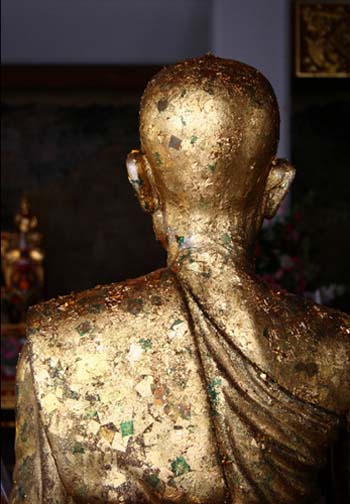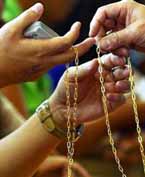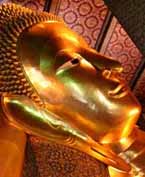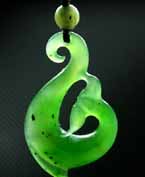Tags

Applying gold leaf to a Buddhist statue is a way to make merit in Thailand. It’s also a good way for a temple to make some bucks.
I’ve had the problem in the past of convincing first time visitors to Thailand that all those gold statues and Buddhas at wats are really gold. Not solid gold, short of the one at Wat Traimit, mind you. But smothered in it, yes. And with dozens of images coated in gold at even the smallest temples, that’s a lot of moola. Especially with gold running about $1,260 an ounce these days. Granted, if the locals sprinkled cocaine on their gods instead of rubbing gold leaf all over them we’d really be talking some major bucks. But the Thai government tends to frown on drugs – at least those they can make money off from jailing people – and white Buddhas just ain’t as popular as the gold ones are.
Since I recently recommended a great touri activity when visiting Wat Pho is to scrape some of that gold off for a souvenir, I thought I’d look into just how much baht that might net you. Or if taking home a sheet or two of the gold leaf they sell at wats would be a better course of action (not taking into account the impact stealing from the Buddha might have on your karma). I suspect the gods are already taking out their revenge on me, ‘cuz that not only means doing math but using the metric system too. But since I mastered converting ounces into grams back in the ’80s, I thought I’d give it a go.
I shoulda allowed that math thingy to scare me away as it usually does. Because gold is weighed in troy ounces, rather than avoirdupois ounces, so the 28 plus change grams per ounce I learned as a fledging drug dealer in my youth doesn’t apply. And then, ‘cuz this is Thailand, the unit of weight measurement is Baht, which is different yet. And then it depends on the percentage of gold versus other metals you are talking about too – typically in Thailand this is 23 carat, which is 96.5% pure (while in the U.S. you normally find 24 carat gold which is 99.95% pure).
What the other metal or metals added to the gold is matters too. Typically that’s a mix of silver and copper. But in gold leaf it’s usually a case of either or: when copper is added it’s called red gold leaf, when silver is added it’s green gold leaf. So the gold leaf you buy (or scrape off a statue) at a temple may be 24K gold, 23K gold, or even 18K gold; it may have additional copper or silver added to it; and, there is chemically produced fake gold for sale at wats too.
Now you’d think as expensive as gold is these days, regardless of the purity you are dealing with, manufacturing gold leaf would be extremely controlled and its thickness carefully measured. But in Thailand most gold leaf is still pounded by hand. The factories, which are mostly small family run businesses, machine roll gold bullion into paper-thin sheets. Then it’s cut into 50 millimeter square pieces and given to a craftsman who hammers it into a sheets about twice the size of his hand, a process that takes about 6 hours (and for which he earns about 100 baht per hour).
The resulting sheets of gold leaf, which are about one ten thousands of a millimeter thick, are then cut into 3.5 – 4 cm squares, which are packed in small carded envelopes and sold by the bundle, not by weight. Typically, a manufacturer gets three to seven square meters of gold leaf from one gram of gold. And how does that craftsman know when he’s pounded the gold leaf to the proper thickness? By the sound his hammer makes when it strikes the sheeting.
So, as imprecise as the manufacturing is, coupled with the various degrees of purity of the gold used, attempting to value just what the gold leaf you scrape off a Buddha would be worth is a losing proposition. Not that actually buying a few sheets helps in anyway. Because, of course, what one temple charges for those small squares of paper-tin gold leaf has nothing to do with what another temples charges its merit makers. It’s enough to make me suggest you go to Chinatown and shoplift some gold instead. But the Buddha would probably be less vindictive about your thievery from his image than a merchant in Chinatown would be. The good news is that if you get caught, gold leaf is extremely thin and easily swallowed; eating it is considered safe. So bye-bye evidence. And as Master Card would put it: Not getting busted for stealing gold from the Buddha in Thailand: priceless.
| Related Posts You Might Enjoy: | ||






How obtuse can you persist to be regarding the “imperial system” ! Even the brits are abandoning it. Switch to modern times !!!
Regarding the “beating of the gold” : when you go to Myanmar, you can still see workers beating the gold on cushions, and I doubt if they get 100 bahts a day !
Yes but dividing by 10 instead of 12 is so tricky!
🙂
Gallons versus litres, ounces versus grams? Sweet titty-fucking twinks, and you Yanks think you’ve got a handle on the world? No wonder the wedding seasons of India and Southeast Asia don’t register It’s not all Dow Jones, you know! You don’t RUN the world, you merely operate within the existing model. That is all Commodore Perry secured you, and that is petering out, you poor prawns. Your legacy will the shell of abandoned Hard Rock Cafés across Asia, but gold will still be beaten by hand in villages, by generations of families, and not the Madoffs of America.
I thought the Hard Rock Cafes were an English invention.
We gave the world McDonalds.
And the Big Mac will out last us all.
🙂
Dear me, I went on a bit didn’t I? Sorry.
You should have taken to my post, above, with a red pencil. (Note to self: don’t post when ‘tired and emotional’.)
More importantly, don’t off a bar boy when tired and emotional!
Wow, talk about bad teeth, bad humor, & bad weather! British Culture = Spice Girls, the looted Elgin Marbles, and inbred royals.
ChristianPFC loves gold! Any idea where he can observe this process of making gold leaf?
ChristianPFC really needs to stop referring to himself in the third person.
🙂
I don’t know of any places open for you to visit in Thailand. But you can in Burma. So maybe that’s a good excuse for your next visa run . . .